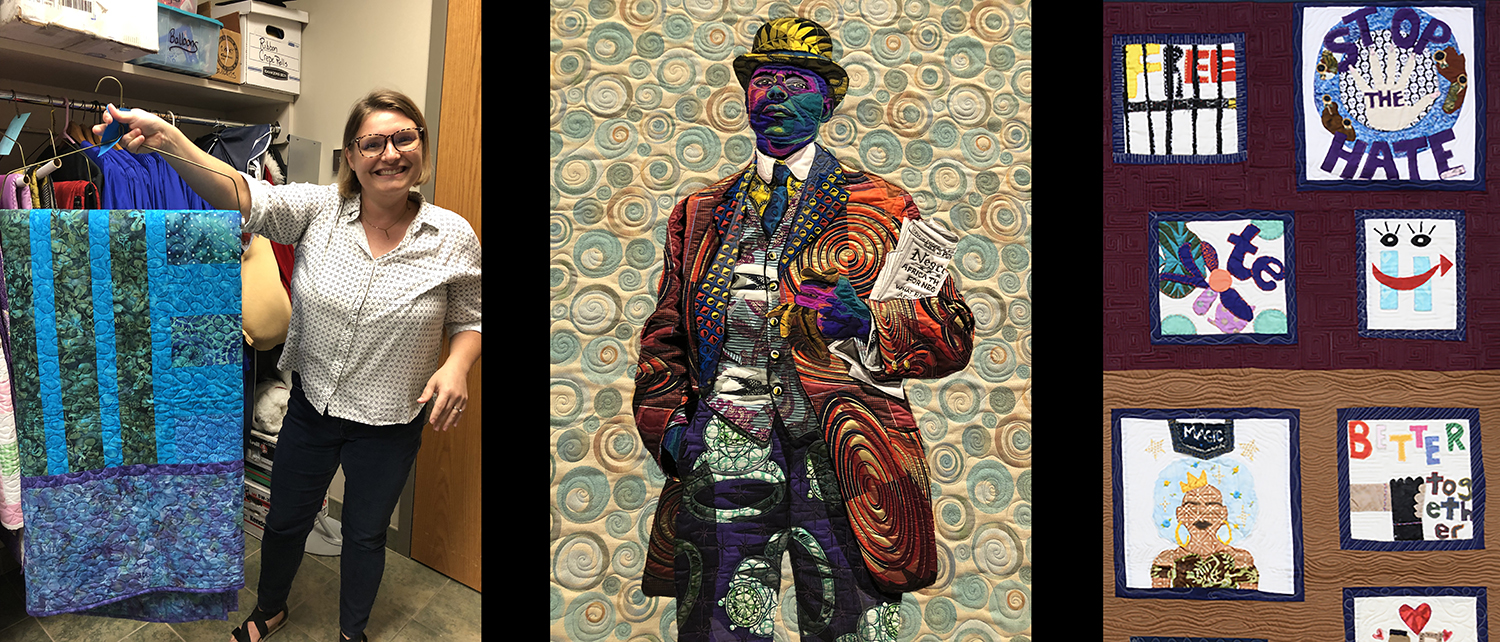Q is for Quilt. It starts small – with an idea, perhaps some bits of beloved clothing too worn to wear, a sense of color and shape, and a design develops. Blocks to assemble or one big picture for the display front, then it’s given a backing and some kind of padding between. Stitch together into a firm bit of function: covering, warmth, protection, beauty. Many hands can participate in its making. A quilt is also Art. Expression. Activism. Community. Ingenuity. Healing. Gift. Joy.
I encountered each in a recent amble around Champaign-Urbana and environs; it’s my pleasure to share them with you. There’s something buried deep in the human psyche around the letter Q – the Phoenician symbol koph has its origins in the glyph for the eye of a needle. More about that at the end.
Ready to roll?
My journey began in June at one of my favorite annual events, the Festival of Quilts at Cunningham Children’s Home in Urbana. For 17 years it has gathered a stunning array, some 200 this year, to sell in support of CCH’s programming for children. Quilts have been central to its work since 1895, when Judge Joseph and Mary Cunningham deeded their home and 15 acres to the women of the Methodist Episcopal Church to be used for the safety and nurture of children in need. A robust group of quilters immediately stepped in to craft and donate a quilt as welcome to each child entering the home, a tangible gift of warmth, nurture, and healing. In 2019, 777 children received services, and there was a quilt for each of them. Some thousand a year now pass through the quilt closet housed in the spiritual life center, a pilgrimage point for quilters — one this year aged 104 — who come from far away to deliver their handmade creations.
The campus has grown to include a residential unit for 60 children and two schools accredited under the Urbana School District. Other programs serve teen mothers, runaways and homeless youth, and unaccompanied immigrant children through its program Caminos, under the Office of Refugee Resettlement, and more. As one child said, his quilt is something beautiful made from cast-offs – just like his life at CCH.
I ran through the logistics of the festival with Colleen Combes, Event and Volunteer Specialist, and Kathy Perisho, a skilled quilter who is the Cunningham representative to the United Methodist Women’s Illinois Great River District. Here they are, Perisho at left, enjoying the magic and mystery of that quilt closet.
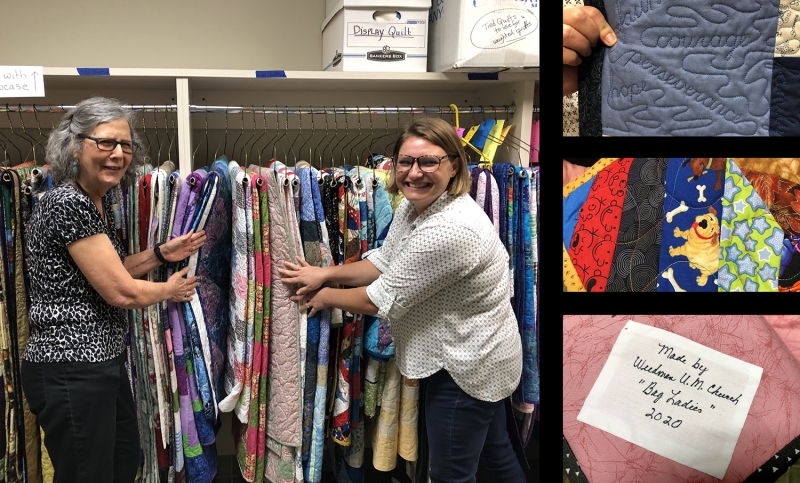
Photos by Cope Cumpston.
The students are active participants; they make their own blocks that are assembled by skilled stitchers. Here is this year’s student quilt, alongside the much-prized superhero blankets donated for sale.
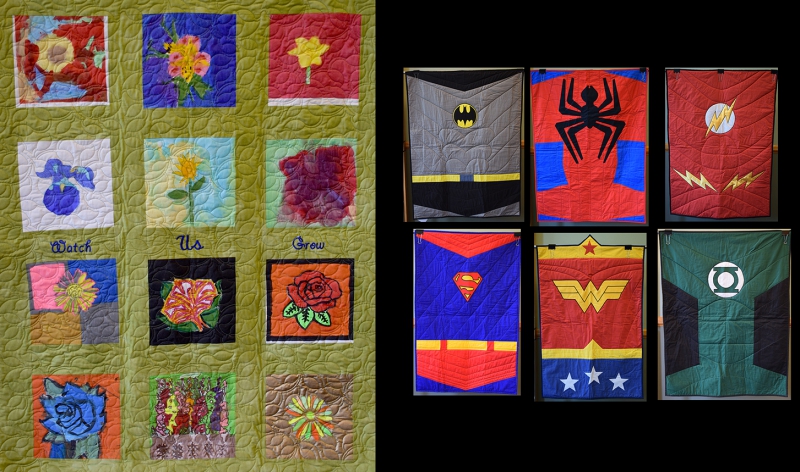
Photos by Cunningham Children’s Home.
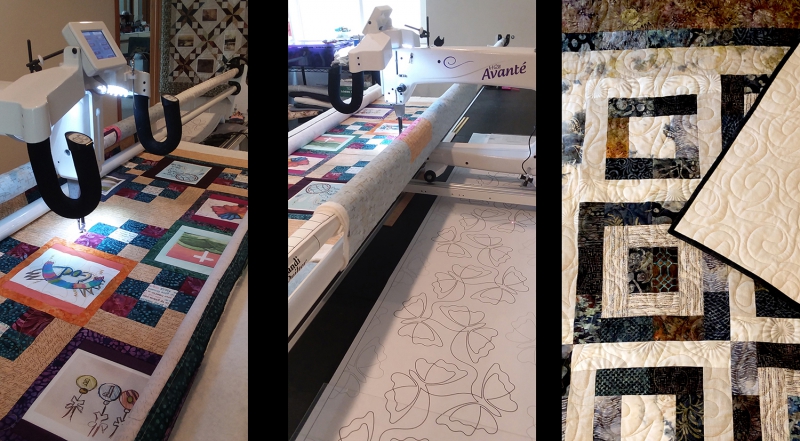
Photos by Kathy Perisho.
Above is a glimpse of Perisho’s longarm machine; she traces her pattern with a pantograph to direct the needle in the intricate work you can see in her finished piece, Roundabout.
Perisho is a member of the Illini Country Stitchers, formed in 1985, the Champaign-Urbana guild that brings together over 110 enthusiasts for community, collaboration, education, and service. They meet twice monthly, currently on Zoom, and share their savvy through show-and-tell, visits to out of town exhibits and stores, and programs with teachers from around the country.
Service has always been the essence of quilting. The Stitchers contribute to Project Linus, a national group providing blankets to children who have experienced illness, and Quilts of Valor, which donates to veterans.
They hold a show every other year; play “block lotto,” and challenge each other with projects to stretch their imaginations and craft. They are active with community needs, stitching dog beds for the Humane Society and over 10,000 pandemic masks. Take a look at their calendar; visitors are welcome.

© Bisa Butler, details of The Tea, 2017; The Safety Patrol, 2018; Asantewa, 2020, images from The Art Institute.
The world of High Art has not often given quilts a place at the altar, but a show at the Art Institute of Chicago has gathered enough buzz to lure me onto Amtrak for the first time since COVID. You have until September 6th to be stunned by the portrait quilts by Bisa Butler, who has taken a place front and center for the sheer genius of her narratives around African-American lives.
She has an uncanny ability to add dimension and subtlety through pattern and texture and touches of thread, using chiffon layered over fabric to create shadows and depth. The crowning touch of the exhibit is a playlist she compiled with her husband John, a professional DJ, matching a song to each portrait. Luxuriate over the details of Southside Sunday Morning, drawn from the Russell Lee photograph, accompanied by Curtis Mayfield’s Move On Up.
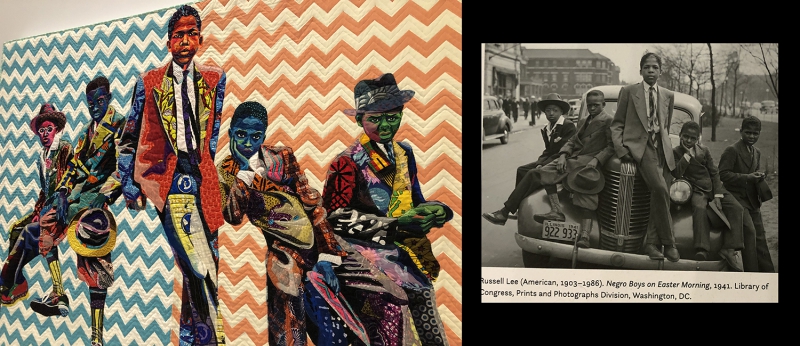
@Bisa Butler, Southside Sunday Morning, 2018, photo by Cope Cumpston.
Butler’s artistry points directly to another exhibit of quilts at a Chicago museum, Intuit — The Center for Intuitive and Outsider Art. Their summer program Intuiteens brings together youth who are drawn to community work and immerses them in the world of self-expression and art. This summer’s group of 13 was a natural match for a collaboration with Sara Trail, an artist who brings young energy and urgency to the long history of quilts that spotlight social concerns, from abolition to temperance, to remembrance of lives lost, perhaps most famously in the largest piece of community folk art ever, the AIDS Memorial Quilt.
In 2015 Trail founded the Social Justice Sewing Academy in Los Angeles, and struck a chord that brings together youth, community, and the art of quilting to give voice to a rising generation of “artivist craftivists.” Trail spent a week with this summer’s Intuiteens, guiding them to use quilt design to answer the question “What impact do you have on changing societal issues?” They learned the subtleties of designing a clear message and translating that to a collage of fabric in a quilt block. Experienced quilters put the finishing embroidery on the blocks and assemble them into quilts. The final product goes on public display and opens doors for youth whose concerns are too often not heard. The ultimate goal is to amplify youth voices through the community and art of quilting.
Enjoy the rich network of quilters in this conversation between Trail and Bisa Butler, shown alongside the SJSA community quilt now on view at Intuit.
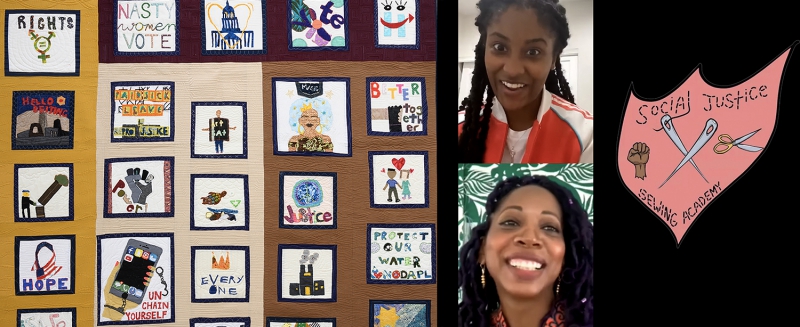
Photos from Intuit and Social Justice Sewing Academy.
On display through August 22nd, virtually and in person, is their collaborative exhibit, Connecting Generations Through Cloth.
Their youth quilts were a highlight at the Modern Quilt Guild’s annual show and meeting, QuiltCon, in 2019. That opened a direct conversation between older quilters and the young artists. The call is out for quilts in the “social justice” category for the 2022 QuiltCon.
I was intrigued with the idea of the “Modern Quilt Guild” and discovered that there are two Illinois chapters, in Chicago and Bloomington/Normal. Modern quilters tend to be tech savvy and drawn to new ways of displaying and brainstorming quilt designs. Here are four from the Bloomington/Normal group that capture the spirit; the two on the left are by president Nancy Powell; on the right by Kathy Cook. Powell teaches math and technology; her quilt on the far left, Hexadecimal, is a message based on ASCII code — “BNMQG together 2020-21.”

Photos by Nancy Powell (two on the left) and Kathy Cook (two on the right).
Cook was intrigued by a challenge that has caught on – “temperature quilts.” The idea is to assign a color palette for the span of degrees that extends to the highs and lows of the year. In her design of 365 blocks, each day’s background is the low color, with a contrasting bar of the high. The bar rises, falls, or stays level corresponding to that day’s change between high and low. Quilting takes on global warming. Beauty and activism in one gorgeous gesture.
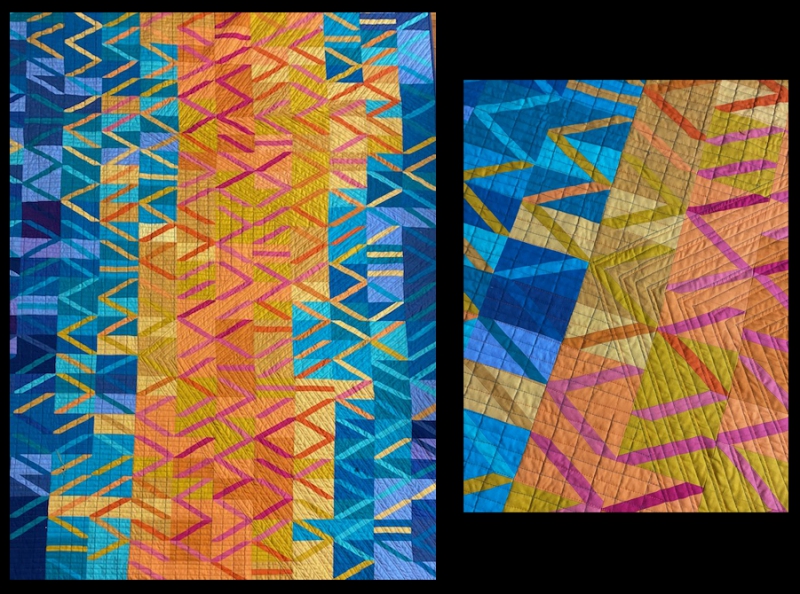
Photos by Kathy Smith.
Two links are worth a mention. Local store Everyday Quilting in Sunnycrest Mall in Urbana offers a generous supply of advice, materials, and technical support. Go there for quilters’ preferred 100% cotton with attention to colorfast dyes, and fabric 108” wide for seamless quilt backings. A large classroom is open for workshops and groups who need large working space. The owner welcomes collaborators on Quilts of Valor and donates regularly to “Remember,” a project to benefit the Lakota Sioux of the Pine Ridge Reservation. They have a Gammill Vision longarm machine and will assemble finished quilts.

Photos by Cope Cumpston.
Just under four hours south on I-57 you will bump into the Ohio River and the incomparable National Quilt Museum in Paducah KY. Its collection is decidedly modern; everything displayed dates after 1980. Exhibits change frequently and bring superb art from far and wide, with attention to school-age student blocks and quilts made around issues of social justice. To whet your appetite here’s a selection from my visit last February. From left to right, Fire on the Water by Judy Dales; Colourful Dream by Louise Bélanger; Ewe are my Sunshine by Janet Stone, and my personal favorite, Swamp Girl Meets Ester Williams by Karen Linduska.

Photos by Cope Cumpston.
What about that letter Q? As I mentioned above, it is likely that our letterform originated with the Phoenician letter koph, whose shape came from a glyph for the eye of a needle. The Greeks took this for their kappa, and the Romans added the curly tail. Another thread may relate to the Hebrew letters for monkey, with that telltale curlicue. I can see some correlations with quilting. In any case, it’s a history with much room for illustration – perhaps a quilter will take it on.

Cope Cumpston is resident book designer, typographer, and community enthusiast. The archive for Abecedarian Amble lives here.








